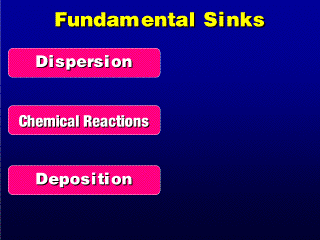 Most of the various sink processes can be classified into one of these three
fundamental sink categories.
Most of the various sink processes can be classified into one of these three
fundamental sink categories. Most of the various sink processes can be classified into one of these three
fundamental sink categories.
Most of the various sink processes can be classified into one of these three
fundamental sink categories.
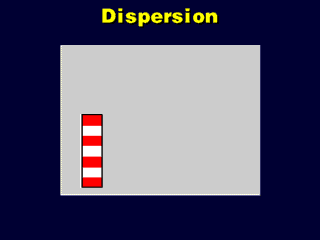 When pollutants are emitted into clean air, the clean and polluted air mix,
diluting the contaminants. Over time, air movement (such as from wind) can dilute
the pollution enough so that it will not be harmful to life.
When pollutants are emitted into clean air, the clean and polluted air mix,
diluting the contaminants. Over time, air movement (such as from wind) can dilute
the pollution enough so that it will not be harmful to life.
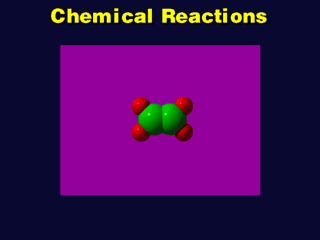 When gases react, other substances are produced. The original pollutant(s)
then disappear. It may be that the products of the reaction are also pollutants,
so a chemical reaction could be a source of one or more pollutants while it
is a sink for one or more other pollutants.
When gases react, other substances are produced. The original pollutant(s)
then disappear. It may be that the products of the reaction are also pollutants,
so a chemical reaction could be a source of one or more pollutants while it
is a sink for one or more other pollutants.
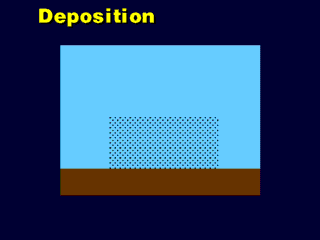 Solid aerosol particles eventually settle out of the atmosphere due to gravity.
This category also includes the impaction of aerosols and gas molecules onto
solid surfaces near the ground (the particles or gas molecules collide with
the solid object and stick to the object). This is known as "deposition".
Solid aerosol particles eventually settle out of the atmosphere due to gravity.
This category also includes the impaction of aerosols and gas molecules onto
solid surfaces near the ground (the particles or gas molecules collide with
the solid object and stick to the object). This is known as "deposition".
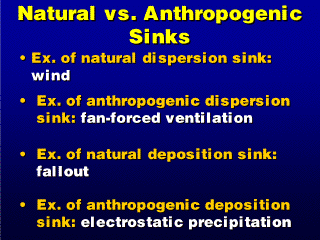 In this case, humans are responsible for removing the pollutants from the
air. These are essentially the three processes noted above and enhanced by humans.
In this case, humans are responsible for removing the pollutants from the
air. These are essentially the three processes noted above and enhanced by humans.
The process illustrated in the movie shown in class is called electrostatic precipitation, where electrostatic charges are placed on pollution particles and attracted to an oppositely charged collector. Negative ion generators are actually electrostatic precipitators.